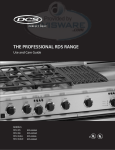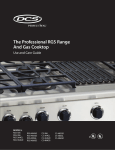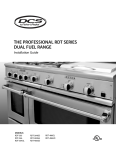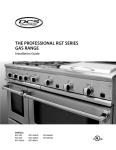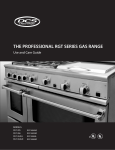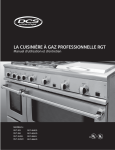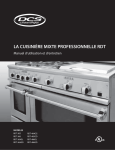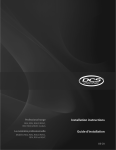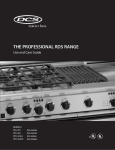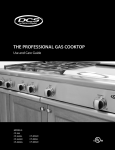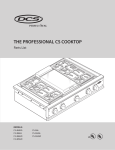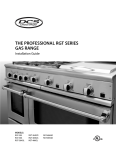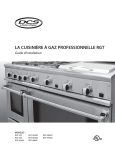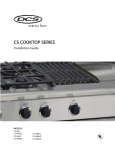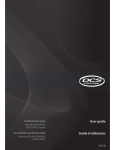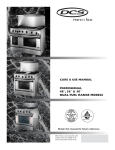Download DCS RDT-486GD Specifications
Transcript
THE professionAL RGT SERIES GAS RANGE Use and Care Guide ModEls: RGT-305 RGT-366 RGT-364GL RGT-364GD RGT-484GG RGT-485GD RGT-486GL RGT-486GD A MESSAGE TO OUR CUSTOMERS Thank you for selecting this DCS Professional Gas Range. Because of this appliance’s unique features we have developed this Use and Care Guide. It contains valuable information on how to properly operate and maintain your new appliance for years of safe and enjoyable cooking. To help serve you better, please fill out and submit your Product Registration by visiting our website at www. dcsappliances.com and selecting “Customer Care” on the home page and then select “Product Registration”. In addition, keep this guide handy, as it will help answer questions that may arise as you use your new appliance. For your convenience, product questions can be answered by a DCS Customer Care Representative by phone: 1-888-936-7872, or email: [email protected]. NOTE: Please write the Model and Serial Number on this page for references (located on rating plate on the back panel and also on the front frame, right lower corner between the kick panel and the oven door). MODEL NUMBERSERIAL NUMBER NOTE: Inspect the product to verify that there is no shipping damage. If any damage is detected, call the shipper and initiate a damage claim. DCS by Fisher & Paykel is not responsible for shipping damage. DO NOT discard any packing material (box, pallet, straps) until the unit has been inspected. WARNING! Improper installation, adjustment, alteration, service or maintenance can cause property damage, injury or death. Read the installation, operating and maintenance instructions thoroughly before installing, using or servicing this equipment. WARNING! If the information in this manual is not followed exactly, a fire or explosion may result c ausing property damage, personal injury or death. Do not store or use gasoline or other flammable vapors and liquids in the vicinity of this or any other appliance. DANGER If You Smell Gas: 1.Do not try to light any appliance. 2.Do not touch any electrical switch; do not use any phone in your building. 3. Immediately call your gas supplier from a neighbor’s phone. Follow the gas supplier’s instructions. 4. If you cannot reach your gas supplier, call the fire d epartment. 5. Installation and service must be performed by a q ualified installer, service agency or the gas supplier. WARNING! To reduce the risk of injury to persons in the event of a cooktop grease fire, observe the following: Turn burner off first. Smother flames with a close-fitting lid, cookie sheet, metal tray, baking soda or use a dry chemical or foamtype fire extinguisher. Be careful to prevent burns. If the flames do not go out immediately evacuate and call the fire department. Never pick up a flaming pan - You may be burned. DO NOT USE WATER ON GREASE FIRES, including wet dishcloths or towels - a violent steam explosion will result. Use an extinguisher ONLY if: 1. You know you have a Class ABC extinguisher, and you already know how to operate it. 2. The fire is small and contained in the area where it started. 3. The fire department is being called. 4. You can fight the fire with your back to an exit. PLEASE RETAIN THIS MANUAL FOR FUTURE REFERENCE. 1 table of contents safety practices model identification before using your appliance cooktop use Burner Use Electronic Igniters Burner Efficiency and Flame Characteristics Cooktop Burners Burner Grates Wok Ring (Purchase Separately) grill use griddle use oven use Convection Baking Traditional Baking Broiling Slow Cooking / Low Temperature Cooking High Altitude Baking Internal Cooking Temperatures Suggested Temperatures to Keep Food Hot 3-5 6 7-8 9 10 10 10 11 11 12-13 13-14 15-16 17-18 18-19 19 19 20 21 Care and maintenance Cleaning Range or Cooktop, Burners Grates and Oven Burners and Igniters Drip Trays and Drain Tubes, Griddle, Grill, Control Knobs Backguard, Oven Door Removal and Installation Oven Racks, Frame, Sides, Door Exterior, Heat Deflector, Door Gasket, Oven Light Bulb Replacement Power Failure 22 23 24 25 26 26 26 parts Identification 27-28 TROUBLESHOOTING 29 how to obtain service 30 warranty 31-32 2 Safety practices and precautions When properly cared for, your new DCS Appliance is des igned to be a safe, reliable cooking appliance. When using this restaurant caliber appliance, use it with extreme care, as this type of appliance p rovides intense heat which can increase the accident potential. Basic safety p recautions must be followed when using kitchen appliances, including the following: n Read this Use and Care Manual thoroughly before using your new appliance. This will help to reduce the risk of fire, electric shock, or injury to persons. n Begin by insuring proper installation and s ervicing. Follow the installation instructions which came with this ap- pliance. Be sure to have a qualified technician install and ground this appliance before using. n Have the installer show you where the gas supply shut-off valve is located so you will know how and where to turn off the gas to the appliance. n If you smell gas, the installer may not have done a proper job of checking for leaks. You can have a small leak and therefore a faint gas smell if the connections are not completely tight. Finding a gas leak is not a “do-ity ourself” procedure. Some leaks can only be found with the burner control in the ON p osition; for your protection it must be done by a qualified service technician. n If by some chance a burner goes out and gas escapes, open a window or a door to let the room air out. Do not at- tempt to use the a ppliance or turn any electrical switch on or off until the gas has had time to d issipate. Follow the instructions on page 1, “For Your Safety– if You Smell Gas”. n This appliance has been factory assembled for natural or LP gas. It should be correctly adj usted from the factory. n Do not repair or replace any part of this appliance unless it is specifically recommended in this manual. All other servicing should be referred to a qualified t echnician. n Children should not be left alone or unattended in an area where appliances are in use. They should never be allowed to turn knobs, push buttons, sit or stand on, and/or touch any part of an appliance while in operation. n Children in walkers, or children crawling can be attracted to the round oven door handle and may grab and open the oven door. This can result in injury from the door being pulled open on a child, or severe burns if the oven is in use and hot. WARNING! Do not store items of interest to children above or at the back of any appliance. Children could be seriously injured if they should climb onto the appliance to reach these items. n Never store anything in the oven or on the cooktop. Flammable materials can catch fire, plastic items may melt or ignite and other types of items could be ruined. n Do not hang articles from any part of the appliance or place anything against the oven. Some fabrics are quite flammable and may catch on fire. n If the appliance is near a window be c ertain the curtains do not blow over or near the cooktop burners; they could catch on fire. n Do not use water on grease fires. Turn all burners OFF, then smother fire with a metal lid, baking soda or use a dry chemical or foam-type fire extinguisher. n Never let clothing, pot holders, or other flammable materials come in contact with, or get too close to, any burner or burner grate until it has cooled. Fabric may ignite and result in personal injury. n Be certain to use only dry pot holders: moist or damp pot holders on hot surfaces may cause burns from steam. Do not use a towel or other bulky or frayed cloth in place of pot holders. Do not let pot holders touch hot burners, or burner grates. n For personal safety, wear proper a pparel. Loose fitting garments or h anging sleeves should never be worn while using this appliance. Some s ynthetic fabrics are highly flammable and should not be worn while cooking. 3 safety practice and precautions n Do not use aluminum foil to line any part of the oven or cooktop. This will cause heat to be trapped underneath it. This trapped heat can upset the cooking p erform ance and can damage the finish of the oven or the cooktop parts. WARNING! NEVER cover any slots, holes or passages in the oven bottom or cover an entire rack with materials such as aluminum foil. Doing so blocks airflow through the oven and may cause carbon monoxide poisoning. Aluminum foil linings may also trap heat, causing a fire hazard. n This appliance is for cooking. Never use the oven or cooktop to warm or heat a room. This could damage the cooktop or oven parts. WARNING! NEVER use this appliance as a space heater to heat or warm the room. Doing so may result in carbon monoxide poisoning and overheating of the oven. n When using the cooktop: Do not touch the burner grates or the immediate surrounding area. Areas adjacent to the burners may become hot enough to cause burns. n When using the oven: Do not touch the interior surfaces of the oven, the exterior area immediately surrounding the door or the back trim. The drip tray handles directly above the oven door may be hot if the oven has been operated with the door open, or if something has prevented the door from sealing. Always use caution when pulling out the drip trays (GD & GL models only) when the oven has been on, or is currently on. The drip trays get hot when the oven is on. Do not remove drip trays until they are cool. n Never leave the cooktop unattended when using high flame settings. When cooking with high flame settings, boil overs may cause smoking and greasy spill overs may ignite. More importantly, if the burner flames are smothered by a severe boil over which effects the igniter, unburned gas will escape into the room. n Only certain types of glass, heat-proof glass-ceramic, ceramic, earthen ware, or other glazed utensils are suitable for cooktop use. This type of utensil may break with sudden temperature changes. Use only on low or medium flames settings according to the manufacturer’s directions. The use of professional utensils is recommended. n Do not heat sealed food containers; a build up of pressure may cause the container to burst. n During cooking, set the burner control so that the flame heats only the bottom of the pan and does not extend beyond the bottom of the pan. This could heat and/or melt the handles, and may increase cooking time. n Always use utensils that have flat bottoms large enough to cover the burner. The use of undersized utensils will expose a portion of the flame to direct contact and may result in ignition of clothing. n To minimize burns, ignition of flammable materials and unintentional spill overs, position handles of utensils inward so they do not extend over adjacent work areas, cooking areas, or the edge of the cooktop. n Hold the handle of the pan to prevent movement of the pan when stirring or turning food. n Grease is flammable. Let hot grease cool before attempting to handle it. Avoid letting grease deposits collect around the cooktop burners. Clean after each use or boil over. n For proper lighting and performance of the cooktop burners, keep the burner ports clean. It may be necessary to clean these when there is a boil spill or when the burner does not light, even though the electronic igniters click. n Do not use the grill for cooking excessively fatty meats or products which promote flare-ups. Do not use cooking utensils on the grill. n Clean the cooktop with caution. Avoid steam burns; do not use a wet sponge or cloth to clean the cooktop while it is hot. Some cleaners produce noxious fumes if applied to a hot surface. Follow directions provided by the cleaner m anufacturer. 4 safety practices and precautions n Be sure all the range and/or cooktop c ontrols are turned off and the appliance is cool before using any type of aerosol cleaner on or around the appliance. The chemical that produces the spraying action could, in the presence of heat, ignite or cause metal parts to corrode. n Place oven racks in desired position while the oven is cool. If a rack must be moved while the oven is hot, do not let the pot holders contact the hot interior lining of the oven. n Use care when opening the oven door; let hot air or steam escape before removing or replacing foods. n Do not rub, damage, move or remove the door gasket. It is essential for a good seal during baking. Wash the gasket with hot water only. n Clean the ventilator hood and filters above the range or cooktop frequently so grease from cooking vapors does not accumulate on them. The filter can be cleaned in a dishwasher or DishDrawer. Follow directions provided by ventilation manufacturer for cleaning. n Turn the ventilator “OFF” in case of fire or when intentionally “flaming” liquor or other spirits on the cooktop. The blower, if in operation, could unsafely spread the flames. n DO NOT obstruct the flow of combustion or ventilation air to the appliance. Be sure a fresh air supply is available. n For safety reasons and to avoid damage to the appliance, never sit, stand, or lean on the oven door or cooking surface. n Service should only be done by a uthorized technicians. Technicians must disconnect the power supply before s ervicing this appliance. WARNING! California Proposition 65 - The burning of gas cooking fuel generates some by-products which are known by the State of California to cause cancer or reproductive harm. California law requires businesses to warn customers of potential exposure to such substances. To minimize exposure to these substances, always operate this unit according to the instructions contained in this booklet and provide good ventilation to the room when cooking with gas. recommendations on hook-up to gas supply: A manual valve must be installed external to the appliance, in an accessible location from the front for the purpose of shutting off the gas supply. The supply line must not protrude beyond the back of the unit. Make sure the gas supply is turned off at the wall valve before connecting the appliance. The gas supply connections should be made by a qualified technician and in accordance with local codes or ordinances. In the absence of a local code, the installation must conform to the latest edition of the National Fuel Gas Code ANSI Z223.1. NOTE: This product must be installed by a licensed plumber or gas fitter when installed within the Commonwealth of Massachusetts. NOTE: (mandatory for the State of Massachusetts) Alternate method of supplying gas must be installed into the unit. Installer supplied shut-off valve must be easily accessible inside cabinetry. Gas Supply 5 model identification 48” RGT range models RGT-484GG RGT-486GL RGT-486GD RGT-364GL RGT-364GD RGT-485GD 36” RGT Range models RGT-366 30” RGT range models RGT-305 6 before using your appliance 1. Remove all packaging materials and labels from your appliance. If the installer has not set up your appliance, do it now. Check that you have the following items: Cooktop n Griddle cover - (RGT-364GD, RGT-486GD, RGT-485GD, and RGT-484GG models only) n Grill cover - (RGT-364GL, RGT-484GG, and RGT-486GL) n Grill grates, 2 pieces - (RGT-364GL, RGT-486GL & RGT-484GG models only) n Burner head assemblies, burner caps and grates (5 burner heads on RGT-305 and RGT-485GD models only, 4 burner heads on RGT-364 and RGT-484, 6 on RGT-486GD, RGT-486GL and RGT-366) n Radiant tray - to hold ceramic rods for grill - (RGT-364GL, RGT-486GL & RGT-484GG models only) n One removable drip tray (griddle and grill models only have drip tray liners, for catching grease) 24” & 27” OVEN: n One two-piece broil pan n Three oven racks 12” OVEN: n T wo removable side rails n Two oven racks NOTE: If any of the listed accompanying items are missing, contact DCS at (888) 936-7872. Please be prepared with your Model #, Serial # and description of product you have purchased. Regarding use of aluminum foil in a DCS Range Oven: Do not use aluminum foil to cover the oven racks or to line the oven. Heat can be trapped beneath the foil; this can cause damage to the oven and cause food to not cook correctly. 2. Place the oven racks in the proper position before turning on the oven. For correct rack position check your recipe. The most frequently used position is number 2 (the food product must be in the center of the oven for airflow). The rack positions are numbered from the bottom as in the floors of a building (Fig. 01). 3. Before baking or broiling: One at a time, turn the oven and broiler burners “ON” for 20 to 30 minutes each. This burns off the manufacturing oils used by the factory. Turn the oven burner on to 450º F and the broiler burner on to “BROIL”. Turn on the ventilator above your range while these burners are on, as there will be an odor. Rack Positions 4 3 2 1 4 3 2 1 Fig. 01 7 before using your appliance To insert the oven racks IN 12” OVEN: 1. Hold the rack with the back safety rail in the up position and towards the rear of the oven. Slip it into the oven so the rack slides are between the rack and the rack guides. 2. As you slide the rack into the oven, tip the front of the rack up slightly, so that the safety stops on the back of the rack, clear the rack slides (see Fig. 02). The safety stops keep the rack from sliding out of the oven when pulled forward. Rack slide To insert the oven racks IN 24” and 27” OVEN: 1. Hold the rack with the back safety stop in the up position and towards the rear of the oven. Slip it into the oven so the rack rails engage and ride on the rack rollers. 2. As you slide the rack into the oven, tip the rack up slightly (see Fig. 03), so that the safety stops on the back of the rack slide over the rollers in the oven. The safety stops keep the rack from sliding out of the oven when pulled forward. To remove or reposition the racks: 1. Pull the rack forward. 2.Lift the front of the rack up so the safety stops clear the rack slides/rollers. 3. Pull the rack forward. 15º - 20º 15º Fig. 03 8 Rack guide Safety stop Fig. 02 cooktop use burners Cap Your new professional gas range is equipped with burners typical of those used in restaurants. These burners are designed for maximum cleanability and controllability. The large cap spreads the simmer heat out to avoid too much heat being concentrated on the center of the pan. The simmer flame is always “on” when the burner is in use. The burner should never be operated if the cap is not in place. All the cooktop burners have electronic spark ignition to eliminate continuously burning pilots; when the burner is on and the flame is blown out, it will relight. Brass Port Ring Simmer Flame Fig. 04 Simmering Your new professional cooktop has exceptionally low simmering capabilities. The large cap serves as a heat diffuser to spread out the heat to avoid h aving a center hotspot. Keep in mind that because of the high heat capacity of the retention flame, and the mass of the cast iron burner grates (they retain heat longer than lighter, conventional grates) some foods may continue to cook by retained heat after the burner has been turned off. Should a strong draft or boil over extinguish the simmer flame it will relight automatically as the main burner would. 2 4 6 2 Burner L ocation 1 2 3 4 5 6 Max.Simmer/Low Btu/hr Btu/hr NatLP NatLP 17,500 15,000 500-1,200 500-1,200 12,500 12,500 500-1,200 500-1,200 12,500 12,500 500-1,200 500-1,200 17,500 15,000 500-1,200 500-1,200 17,500 15,000 500-1,200 500-1,200 17,500 15,000 500-1,200 500-1,200 2 4 4 5 1 5 3 RGT-366 cooktop section shown 1 1 3 RGT-364 cooktop section shown 3 RGT-305 & 485 cooktop section shown 2 4 2 4 6 1 3 1 3 5 RGT-484 cooktop section shown RGT-486 cooktop section shown 9 cooktop use Electronic Igniters If a burner does not ignite, listen for the clicking sound. If the igniter is not clicking, TURN OFF THE BURNER. Check the circuit breaker for a blown fuse or a tripped circuit breaker. If the igniter still fails to operate, see page 30, “Before Calling For Service”. To light the burner manually, see page 26, “Power Failure”. Igniter (Keep Clean) NOTE: If you are using propane gas, a slight pop or flash may occur at the burner ports a few seconds after the burner has been turned “off”. This “extinction pop” is normal for propane gas. Fig. 05 Burner Efficiency and Flame Characteristics It is necessary to keep the burner ports and the igniters clean for proper lighting and efficient performance of the cooktop burners (Fig. 05). The burner flame should burn completely around the burner with no excessive noise or lifting. The flame should be blue in color and stable with no yellow tips. An improper air-gas mixture may cause either a b urner flutter or a yellow tipped flame. During initial use, foreign particles in the gas line, or dust in the air around the appliance may cause an orange flame. This will disappear with use. Proper Flame Height Flame Height The correct height of the flame mainly depends on the size of the bottom of the cooking utensil, the material of the cooking utensil, the amount and type of food and the amount of liquid in the utensil. Following are some basic rules for selecting flame height. Fig. 06 n For safety reasons the flame must never extend beyond the bottom of the cooking utensil. Never allow flames to curl up the side of the pan (see Fig. 06). This will discolor or damage the utensil. n Utensils which conduct heat slowly (such as glass-ceramic) should be used with medium to low flame. If you are cooking with a large amount of liquid, a slightly larger flame can be used. n Broiler: The broiler flame should be approximately 1/8” thick and blue (Fig.07) . This is set at the factory for correct performance. Screen Screen should should be red beglowing glowing red Flame be Flameshould should be approximately approximately 1/8” 1/8" thick and blue thick and blue cooktop BURNERS The cooktop burners must be kept clean. Cleaning of the cooktop Fig. 07 burners should include the igniter. The cooktop burners have an infinite number of heat settings and there are no fixed positions on the control knobs between HI and LO. To turn the cooktop burner on, push in on the control knob and turn it counterclockwise to the “LITE” position. An audible clicking sound will be heard. When the gas has been ignited by the electronic spark igniter, turn the knob to the desired setting. (The clicking sound should stop as soon as the burner is lit). WARNING! When turning on any cooktop burner, be sure to stop at the “LITE” position before turning the burner to a flame setting for cooking. If the burner is not lit and it is turned beyond the “LITE” position, to HI, MEDIUM, or LO, there could be a burst of flame when the burner does light. 10 cooktop use Burner Grates The burner grates are heavy cast iron. They have a flat surface making it easy to move large pans from one burner to another. They were designed in sections to make them easier to remove and clean. (See Fig. 08 & 09) cookware For best results we recommend using professional cookware. This type of utensil can be found at Fig. 08 (305 & 485 models) your finer department stores, specialty cooking shops, or restaurant supply stores. If using regular cookware, be very careful if the pans have plastic handles, as these large professional size burners can flame up on the outside of the pan and melt or bubble the handles. Fig. 09 (36” & 48” models) CONTROL KNOBS The control knobs are readily associated with the burners they control. The cooktop control knobs are labeled and are in front of the burners. The oven controller is placed slightly lower than the other control knobs. This is due to the physical size of the commercial type thermostats used on the product (see Fig. 10). Fig. 10 wok ring (Purchase separately) A Wok ring is available as an accessory for your new DCS appliance. To purchase a wok ring accessory (model # WRS) for use on your range or cooktop please contact an authorized DCS Dealer. The ring is cast iron, and has a porcelain enamel finish. It can be used with the DCS model CW wok and most commercially available woks. To use the ring, place it on the grate over the desired burner. The vertical tabs on the ring should be aligned with the main fingers of the grate. The small protrusions on the bottom surface of the ring should straddle the grate fingers to prevent the ring from rotating during cooking. See Fig. 11. The bottom of the wok should be supported and retained by the vertical tabs of the ring. For best performance on 305, 36” and 48” model ranges, the ring and wok should be used on the burners that are in positions 1,4,5,6 (see page 9) as they have the highest output on the top section. To clean the wok ring, place it in the dishwasher after use. Stubborn food deposits may be removed by soaking to loosen the soil, then washing as usual. Fig. 11 11 grill use Grill The two grill grates are reversible (see Fig. 12). The grill grates are made of durable stainless steel. One side of the grate is ridged (side A) and should be used for foods where you want the fat to run off, such as steak or hamburger patties. The ridges are slopped so the fat runs toward the front of the grill and can easily run down to the cooler area of the drip tray and away from the intense heat of the burner. The other side of the grate (side B) is designed for foods that need more support while cooking, such as fish and vegetables. Food cooked on the grill section achieves the same flavor as food cooked on an outdoor grill. The intense radiant heat from the ceramic rods caramelizes the fats and juices that are brought to the surface of the food, giving it the barbecued flavor. electric glow igniter The grill burners are equipped with an electric glow igniter and safety valve system which lights the gas. There will be a delay of 30 to 90 seconds after the control knob has been turned on to when you actually hear the burner come on. The burner will ignite within 4 seconds after the gas reaches the burner. Side A Side B NOTE: This gas grill may cook slightly faster than you are used to, thus preheat and grilling times should be adjusted accordingly. ceramic rods The layer of ceramic rods, under the grill grates, will last for many years with proper care. They are shipped from the factory pre-assembled in the radiant tray, ready to be set in place into the fire box, under the grill grates. Be sure to remove any packaging material from the radiant tray and rods before using the grill. Burned food particles and ash can be emptied off the radiant tray when cool by shaking over a waste receptacle. Chipping or cracking of the ceramic rods may occur as they may Fig. 12 get b rittle with age, depending on frequency of use. This is normal and does not affect the cooking performance. Do not replace the radiant tray/ceramic rods with alternates. Contact DCS for genuine factory-direct replacement parts, 1-888-936-7872 or see page 1 for contact information. use of the grill Before starting to cook on the grill, be sure the drip tray and liners are in place and that you have the grill grates turned to the side you want for grilling. Preheat the grill for 15 minutes with the control knob set on “HI”. Place the food on the grill. Grill it to the doneness desired. The control knob may be set to any position between “HI” and “LO”. For proper searing and browning, the grill requires high heat. With large pieces of meat or poultry, you may need to turn the heat to medium to low setting after the food has been seared. This lower heat setting will allow the food to cook through without burning the outside. When using a sugary marinade or barbecue sauce, it may be necessary to turn the heat setting down near the end of the grilling time. Do not leave the grill unattended while it is turned on. When you are finished grilling, allow the drip trays to cool before cleaning them. They should be cleaned each time they are used. NOTE: The longer you preheat the grill, the darker the grill marks will appear. Excessive Flare Ups and Flaming Occasionally grease drippings ignite. These drippings will create minor puffs of flame for a second or two. This is normal when cooking on a grill. You may find it handy to have a spray bottle filled with water to lightly spray the flare-up. If the flame becomes excessive, remove the food from the grill. Lower the heat setting. Replace the food when the flare-up subsides. To prevent flare-ups from happening, trim the fat from around the edges of steaks and chops, use hamburger that is lean, remove the fat that is on poultry, etc. When turning any kind of meat or poultry, the melted fat will drop onto the ceramic rods and it may create a flare-up. If this happens, use a long handled spatula to move the food to another area. 12 grill use grilling hints When grilling, the ventilation fan must be set on “HI” to remove smoke and odors. The fan can be turned to “LO” after cooking is complete to remove any leftover smoke. The doneness of meat is affected by the thickness of the cut. It is impossible to cook a thin piece of meat to a rare doneness. A steak should be at least 1-inch thick to have it turn out rare and juicy. The cooking time is affected by the temperature of the meat when you start to cook it, the size and shape of the cut and the kind of meat you are cooking. The degree of doneness desired also affects the time. When turning the meat over, always use a spatula or tongs as it will not puncture the meat allowing the juices to run out. This will help to keep the meat juicy. Turn the meat only once, as juices are lost when the meat is repeatedly turned. Be sure to trim any excess fat from meat or poultry. To prevent steaks or chops from curling while they are being cooked, slit the fat around the edges at about 2-inch intervals. To test for doneness, make a small cut in the center of the meat. griddle use The built-in griddle on your cooktop is made from Type 304 stainless steel, highly polished to provide a smooth cooking surface. It is normal for it to darken with use as oils cook onto the surface to provide a stick resistant base or “seasoning”. Since the griddle is made from stainless steel, the surface will not rust. The griddle burner is thermostatically controlled and cycles on and off to maintain the set temperature. The Heating light indicates that the burner is “ON”. The Ready light indicates that the griddle is at the set temperature. The griddle assembly is not to be removed for cleaning and is held in place by two front screws and one rear screw. These are mainly there to keep the griddle from shifting in transit, thus avoiding breakage of any ignition components. Once the unit is installed, the rear shipping screw can be removed. It is located beneath the griddle flue cover which is removed by lifting off (be careful not to scratch your backguard during removal of the cover). Remove the center shipping screw. The two outer screws are leveling screws (Fig. 13). They can be turned to level the griddle or to provide a forward slope to help grease and oils drain away from the food being cooked. After using the griddle a few times, you will be able to judge the slope best for the foods you are cooking and your personal preference. Shipping Screw (remove) Outer Leveling Screws (2) griddle flue cover electric glow igniter The griddle burners are equipped with an electric glow igniter and safety valve system which lights the gas. There will be a delay of 30 to 90 seconds after the control knob has been turned on to when you actually hear the burner come on. The burner will ignite within 4 seconds after the gas reaches the burner. Fig. 13 13 griddle use before using the griddle for the first time or to re-season 1. Clean the griddle thoroughly with hot, soapy water to remove any protective coating. 2. Rinse with a mixture of 1 cup water and 1/4 cup white vinegar. Dry thoroughly. 3. Pour 1 teaspoon vegetable oil into the center of the griddle (do not use corn oil as it gets sticky). Rub the oil over the entire surface of the griddle using a heavy soft cloth. 4. Turn the control knob to a Medium setting (350ºF). Turn the heat “OFF” when the oil begins to smoke. Allow the griddle to cool. 5. Repeat Step 3. Be sure to cover the entire surface with the oil. 6. Repeat Step 4. Allow the griddle to cool. Wipe the entire surface of the griddle using a heavy soft cloth. Apply a very thin layer of vegetable oil. The griddle is now ready to use. If the griddle is not used for a period of time, r e-season it occasionally. NOTE: It is normal for the griddle to darken with use. use of the griddle Before starting to cook on the griddle, be sure the drip tray and liners are in place. Preheat griddle for 15 minutes with the control knob set to the temperature suggested on the cooking chart. When the griddle is preheated, the HEATING light will turn “OFF” and the ready light will be “ON”. Place the food on the griddle and cook to desired d oneness. NOTE: When the griddle is properly s easoned it can be used without any additional oil. However, oil can be used for flavor. A light mist of non-stick vegetable spray, applied before cooking to a cool griddle, makes d elicate foods easier to turn. griddle cooking chart FOOD TEMPERATURE Eggs 225ºF to 250ºF Bacon, Ham, Pork Chops 300ºF to 325ºF Sausage, Grilled Cheese Sandwiches 325ºF to 350ºF Pancakes, French Toast 350ºF to 375ºF Hash Brown Potatoes 400ºF to 425ºF 14 oven use OVEN burners Your new professional RGT range is equipped with bake and broil oven gas burners. The oven broiler burner is 19,000 Btu/hr on RGT models. The oven baking burner is 30,000 Btu/hr on 30/36/48” main oven, 18,000 Btu/hr on 12” oven. electric glow igniter The oven bake and broil burners are equipped with an electric glow igniter and safety valve system which lights the gas. There will be a delay of 30 to 90 seconds after the control knob has been turned on before you actually hear the burner come on. The burner will ignite within 4 seconds after the gas reaches the burner. Oven Your large new oven can be used in three cooking modes: convection bake, traditional bake or regular broil. To help you decide which way to cook your food, read this information first. Remember, this is a new oven and the thermostat has been checked for accuracy. Your old oven may have had a thermostat that over the years got a little hot or a little cold. Check your recipes for the correct time and temperature and don’t use the old time or temperature you were using to compensate for your old oven being off temperature. Models RGT-484GG, RGT486GL, RGT-485GD, and RGT-486GD have two ovens. The oven on the right side is the convection oven. The smaller oven, on the left side, can be used in standard bake only. This oven is ideal for baking small amounts of food, when you don’t want to heat the large oven. Oven Racks All ovens have (3) oven racks and 4 rack positions, except the left side oven which on models RGT-484GG, RGT-485GD, RGT-486GL and RGT-486GD has 2 oven racks and 4 rack positions. note: About the roller assisted rack supports (24” and 27” oven only): Specifically engineered from high temperature materials for in oven use, they will stand up to years of use. They are especially functional when the oven racks are supporting the heavy food products associated with this high capacity oven. See page 26 for care of the rack supports. All three ovens come with a 2-pc. broil pan. Preheating Preheating takes about 10 to 15 minutes depending on the temperature set. Preheating is usually necessary for foods baked at high a temperature for a short period of time, i.e. drop cookies. The oven heating light will turn “OFF” and the ready light will turn “ON” when the oven has reached the set temperature. Condensation During any cooking process there is a certain amount of moisture that evaporates from the food. The amount of moisture that condenses on the oven depends on the moisture content of the food. The moisture will condense on any surface that is cooler than the inside of the oven, such as the control panel or the top of the door. CAUTION! Aluminum foil should never be used to cover the oven racks or to line the oven bottom. The trapped heat can damage the porcelain and the heated air cannot adequately reach the food being baked. CONVECTION BAKING Convection Baking is baking with a fan at the back of the oven circulating the hot air in a continuous pattern around the food. This circulating hot air heats and browns the surface of the food more effectively than in a standard mode. This allows most foods to be cooked at lower oven temperatures or in less time, if baked at the regular temperature. The air is recirculated and reheated. Uncovered, longer cooking foods such as large pieces of meat or other foods that can be cooked in low sided baking utensils or air leavened foods, are where you will see the most savings in cooking time. Using multiple racks (3) at the same time will achieve a good time saving, as you can cook more food at the same time. The number of recipes requiring preheating of the oven is reduced considerably because the heat reaches the food faster as the hot air circulates around the food. 15 oven use Foods Suitable for Convection n Appetizers n Breads n Oven Meals (1 to 3 racks) n Cookies n Main Dishes n Roasts n Pies n Poultry n Air Leavened Foods (Angel Food Cake, s oufflés, cream puffs, meringue shells) Setting the Oven The Convection Bake mode is used for baking, roasting or warming using one, two or three racks. To use Convection Bake, push the Convection Switch (located on the control panel) and turn the control knob to the temperature desired. Models RGT-484GG, RGT-485GD, RGT-486GL and RGT-486GD have two ovens. The oven on the left side can be used for traditional bake only; simply turn the control knob to the temperature desired. Converting Recipes for Convection Baking Low-sided baking utensils will give the best results as the hot air can reach all sides of the food easier. The oven temperature can be left the same as the recipe calls for and the food will be cooked in a shorter period of time. The temperature can be lowered 25ºF and the food will probably take the same length of time to cook as the recipe states. If you find that food is adequately browned on the outside, but not done in the center, lower the temperature another 25ºF and add to the baking time. When reducing the temperature, always check the food for doneness a minute to two before the minimum time stated in the recipe, as time can always be added. Some recipes will cook faster than others. There is no way to predict exactly how long each recipe will take when you convert it to convection. Convection will be easier to use after you have used it a few times as you will begin to understand the way it bakes. Selecting Utensils for Convection Baking Cooking by convection does not require any specially designed baking utensils. You probably have many utensils in your kitchen that are suitable to use. When choosing a baking u tensil, consider the material, the size and the shape as they all affect the baking time, the palatability and the appearance of the finished product. Metal bakeware (aluminum, steel and cast iron) all result in the fastest cooking time and the best end product. Aluminum pans work best for all types of baked goods. When baking pies and breads for the best browning, use a pan with a dark or dull finish that absorbs heat. A shiny finish works best for cakes and cookies, since it reflects some of the heat and provides a more tender surface. Cookie sheets with only one lip will give the best results, as the heated air can circulate all around the sides of the food. For roasting, use the bottom of the broil pan and elevate the meat on a metal roasting rack. Glass-ceramic or glass utensils do not conduct heat as well as metal, but they can be used. Use them for foods that do not require a dark brown crust or crisping, such as soufflés. Baked items cook more quickly and evenly if they are individually smaller in size, i.e. two or three small foods do better than one large piece. When single food items are baked, always center the food on the rack. If several foods are being baked, space them evenly on the rack or racks. To Get the Best Results n Follow the recommendations above. n Metal utensils give better results in convection than do glass baking utensils. If you use glass, it usually is not nec- essary to lower the temperature an additional 25ºF. n Use a minute timer and set for less than the minimum time suggested in the recipe, the first time you use a recipe in the convection mode. Be sure to note the new baking time on your recipe for future reference. n Be sure to read the basic information on convection before using the oven for the first time (see page 15). n Keep in mind that convection baking results vary, depending on type of product. In many cases, standard bake yields superior results over convection. Convection Baking Rack Position One to three racks can be used simultaneously during Convection Baking. Place the rack/s in the desired position before turning the oven on. Store the unused racks outside of the oven. Rack position 2 (second from bottom) will probably be used the most for single rack baking. When baking on more than one rack, you do not need to stagger the pans. However, allow at least 1-inch of space between the oven walls and the pans so the heated air can circulate. 16 oven use CAUTION! Aluminum foil should never be used to cover the oven racks or to line the oven bottom. The trapped heat can damage the porcelain and the heated air cannot adequately reach the food being baked. TRADITIONAL BAKING Traditional Bake is used for baking, roasting or warming with hot air; there is no fan. The air movement comes from natural convection. As the air heats, it moves to the top of the oven. This oven mode is the same as you have been using for baking on one or two racks. 12” Oven (48” Ranges Only) The 12” oven comes equipped with (2) oven racks and three position rack supports. The rack supports are removable for cleaning. Also included is a 2-pc. aluminum broiler pan for easy cleaning. Foods Suitable for Bake n Appetizers n Desserts n Pies, Cakes n Main Dishes n Breads n Poultry n Oven Meals (1 to 2 racks) n Roasts To get the best results n Follow the recipe amounts and ingredients, including the size and shape of the baking utensil recommended in the recipe. n Do not open the door “just to peek”, use the interior oven light and look through the window. n Do not use the oven for storage, especially when baking in the oven. Extra utensils, not being used for baking, can affect the food product, the baking time, the browning and end result. n If you are using glass utensils, lower the temperature 25ºF. n Use a minute timer and set for the minimum time suggested in the recipe. Baking Rack Position One or two racks can be used simultaneously during Bake. Place the rack(s) in the desired position before turning the oven on. Store any unused racks outside of the oven. Rack position 2 (second from bottom) will probably be used the most for single rack baking. If you are using two racks simultaneously, be sure to check the food on the bottom rack sooner than the minimum time. The food on the lower rack position may cook slightly faster than the food on the upper rack, particularly if you are using large baking utensils. If you are using two racks simultaneously, be sure to stagger the baking utensils so that one is not directly above the other and the heated air can circulate freely around each pan. Allow at least 1” of space between the oven walls and the pans. If using large or commercial size baking utensils, the food may take a few extra minutes as the air cannot circulate as freely as it does with a smaller pan. When using commercial size baking utensils, use only one rack as the heat does not have the room to circulate. Setting the 12” Oven for Baking (48” Models Only) To use the 12” Oven to bake (smaller oven on left side), set desired temperature on thermostat dial. n The “OVEN ON” light turns on. n The “HEATING” light turns on. n Once the “HEATING” light cycles off the first time, the oven “READY” light will come “On” after the oven is pre- heated. As the oven cools, the “READY” light will go out and the “HEATING” light will come back on. This process repeats when heat is needed. n The “OVEN ON” light remains on until the Thermostat has been turned to the “OFF” position. 17 oven use Setting the 24” & 27” Oven for Baking n The “OVEN ON” light turns on. n The “HEATING” light turns on. n Once the “HEATING” light cycles off the first time, the oven “READY” light will come “On” after the oven is pre- heated. As the oven cools, the “READY” light will go out and the “HEATING” light will come back on. This process repeats when heat is needed. n The “OVEN ON” light remains on until the Thermostat has been turned to the “OFF” position. BROIL Broiling is cooking by intense infrared radiation supplied by the broil burner located at the top of the oven. Place the broil pan in the center of the rack for best results. CAUTION: Pay special attention when setting the Oven Control knob on “BROIL”. If you set the knob past the “BROIL” setting, the burner will not ignite. Foods Suitable for Broil n Top Browning: Casseroles, Breads n Appetizers n Meats n Poultry n Fish Setting the Oven for Broiling Turn the Oven Control knob to “BROIL” (Fig. 14). The burner will ignite after the gas reaches the burner. The “Oven On” indicator light will come on to let Fig. 14 you know that the broiler is currently on. During the broiling process, the infrared burner produces such an intense heat that the burner will cycle on and off to maintain an efficient yet safe interior cooking environment. This cycling process is indicated by the turning on and off of the HEATING and READY indicator lights on the valve panel. All broiling must be done with the oven door closed. This will insure the best in cooking performance while maintaining a cool exterior surface for comfortable use. When checking the doneness of food while broiling, leave the door open only long enough to check temperature or determine degree of doneness. Close door immediately after checking the food. Preheating The broiler does not need to be preheated for most broiling. To increase browning or for very thin food, preheat the broiler 5 to 8 minutes. Using a Meat Thermometer to Broil To accurately determine the doneness of a thick steak or chop (1-1/2 inches thick or more), use a meat thermometer. Insert the point of the thermometer into the side of the meat to the center. Cook the first side to 90ºF for rare meat. Cook the first side to 100ºF for medium to well done. Cook the second side to the desired degree for the doneness you want, 135ºF to 140ºF for rare, and 150ºF to 155ºF for medium and 160ºF to 165ºF for well done. If you are cooking pork, cook to 170ºF. A large two-piece broil pan comes with your new range. When you are broiling, always use both pieces. Do not cover the grid with aluminum foil. This slotted grid allows the grease drippings to flow into the bottom of the pan keeping it away from the intense heat of the infrared broiler burner. This helps to minimize the smoking and spattering of the grease. Broiling Rack Position The rack position depends on the type and thickness of the food. Thick pieces of meat or poultry would typically be broiled on rack position 2 or 3. Steaks, chops and hamburger would be broiled on rack position 4 (top rack) for thinner pieces and position 3 for thicker ones. If top browning casseroles or bread the thickness of the food would indicate the rack position. Casseroles would typically be browned on rack position 2 or 3 and bread on rack position 3. 18 oven use To Get the Best Results n Defrost the food before starting to cook. n Set a minute timer for the minimum time to check the food. Steaks should be at least one inch thick if a rare doneness is desired. It is difficult to get rare with meat that is thinner, or to get a nice brown piece of meat. n After half the total cooking time, turn the food over only once. It is not necessary to turn over thin foods (filet of fish, ham slices, etc.) Liver slices must be turned over. n When top browning, use metal or glass-ceramic bakeware. DO NOT use heat-proof glass or pottery as this type of glassware cannot withstand the intense heat of the broiler burner. n Use a two-piece broil pan. Two-piece broil pans are designed to minimize smoke and spatter. DO NOT cover the slotted grid with aluminum foil. This will catch the grease and could cause a fire. n The broiler pan should be placed all the way to the back of the oven and centered on the oven rack. n All broiling must be done with the oven door closed. This will insure the best in cooking performance while maintaining a cool exterior surface for comfortable use. When checking the doneness of food while broiling, leave the door open only long enough to check temperature or determine degree of doneness. Close door immediately after checking the food. Using the Oven for Slow Cooking or Low Temperatures The oven can be used to keep hot food hot, to dehydrate food, to warm plates, for slow cooking (as in a crock pot), and to defrost foods. You can keep hot, cooked food at serving temperature. Set the oven to the temperature suggested in the chart on page 21. Rare meat must be eaten when it is removed from the oven, as it continues cooking from its own heat. n To keep food moist, it must be covered with aluminum foil or a lid. n To dehydrate food, follow suggestions in a recipe. n To warm plates, check with the dishware manufacturer for the recommended temperature. n To use the oven as a slow cooker, set the oven control knob to 225ºF, place the food in the oven in a pan with a tight fitting lid. Follow recipes for this type of cooking. n To thaw uncooked frozen food, set the oven control knob to “warm”. Be sure the food is tightly wrapped in foil. Thaw the food just enough to handle it. Cook immediately. Do not refreeze. n To thaw frozen cooked food, set the oven control knob to 170ºF. Loosen the freezer wrapping. nDo not use plastic wrap or wax paper in the oven. FOOD SAFETY! According to the United States Department of Agriculture you should not hold foods at temperatures between 40ºF to 140ºF for longer than 2 hours. High Altitude Baking Recipes and baking times vary if you are baking at a high altitude. For accurate information write to the Agriculture Extension Service, Colorado State University, Fort Collins, Colorado 80521. Specify the type of information and the baking mode (convection bake or bake) you need, i.e. cakes, cookies, breads, etc. There may be a cost for the bulletins. 19 oven use Internal cooking temperatures Food Oven Temperature Food Egg and Egg Dishes Eggs Cook until yolk and white are firm Egg Casseroles 160º F Egg Sauces, Custards 160º F Ground Meat and Meat Mixtures Poultry-breast 170°F Duck and Goose 180°F Stuffing Cooked alone or in bird 165°F Sauces, Soups, Gravies, Marinades Used with raw meat, Bring to a boil poultry, or fish Seafood Fin Fish Cook until opaque and flakes easily with a fork. Shrimp, Should turn red and flesh Lobster, should become pearly Crab opaque. Scallops Should turn milky white or opaque and firm. Clam, Mussels, Cook until shells open. Oysters Leftovers 20 180°F Fresh Pork Medium 160°F Well Done 170°F Roast Beef Cooked commercially, 140°F vacuum sealed, and ready-to-eat Chicken, Turkey-whole Chicken, Turkey-dark meat 180°F Turkey, Chicken 165°F Beef, Veal, Lamb, Pork 160°F Medium Rare 145°F Medium 160°F Well Done 170°F Poultry Fresh Beef, Veal, Lamb Oven Temperature 165°F oven use suggested temperatures to keep food hot Food Beef Rare Medium Well Done Bacon Biscuits and Muffins (covered) Casserole (covered) Fish and Seafood French Fried Foods Gravy or Cream Sauces (covered) Lamb and Veal Roasts Pancakes and Waffles (covered) Potatoes Baked Mashed (covered) Pies and Pastries Pizza (covered) Pork Poultry (covered) Vegetables (covered) Oven Temperature 150º - 155ºF 155º - 170ºF 170º - 180ºF 200º - 225ºF 170º - 185ºF 170º - 200ºF 170º - 200ºF 200º - 225ºF 170º - 180ºF 170º - 200ºF 200º - 225ºF 200ºF 170º - 185ºF 170ºF 225ºF 170º - 200ºF 170º - 200ºF 170º - 175ºF 21 care and maintenance When cleaning the range or cooktop: warning! Be careful cleaning any part of this a ppliance while hot. All parts of the appliance can be cleaned with hot soapy water, rinsed, dried and buffed to a shine with a soft, heavy cloth. Always try this first, as it is the mildest cleaning procedure. 1. Use the mildest cleaning procedure first. Some brands of cleaners of the same type are harsher than others, read their directions. A scent or a propellant can make a difference in the product, read the ingredients. Try on a small area first. 2.To avoid marring the surface always rub metal finishes in the direction of the polish lines. The cleaner will be more effective when used in the direction of the polish lines. 3.Use only clean sponges, soft cloths, paper towels, plastic non-metal for cleaning or scouring as recommended in this section. (Use only soap pads with soap still in them. An empty pad can scratch.) 4.Be sure to rinse all parts thoroughly and to wipe dry to avoid water marks. Brand Name cleaners In this section on cleaning, the use of name brands is intended only to indicate a type of cleaner. This does not constitute an endorsement. The omission of any name brand cleaner does not imply its adequacy or inadequacy. Many products are regional in distribution and can be found in local markets and department stores. Cooktop Turn off all the burners and allow the grates to cool before starting to clean the cooktop. If you wipe off any part of the cooktop while it is hot, do so carefully as using a wet sponge or cloth can result in steam burns. Burner Grates When lifting the grates be careful as they are heavy. Place them on a protected surface, so they won’t scratch the surface they are laid on. The burner grates are matte porcelain enamel over cast iron. When cool, they may be placed in the dishwasher, or wiped clean while on the cooktop using hot soapy water, then rinsed and wiped dry. The burner grates will not rust as they are matte porcelain enamel on both sides for durability. The occasional use of mild abrasive cleansers such as Fantastik®, Simple Green® or Formula 409® is okay. Abrasive cleansers, used vigorously or too often, can eventually harm the enamel. Apply with a damp sponge, rinse thoroughly and dry. The porcelain may pop off the edge of the grates due to rapid temperature change when the burners are turned on. Do not be concerned as this does not result in the deterioration of the grates. The cast iron soon darkens to blend with the porcelain enamel. Be careful when wiping an area where the porcelain has popped off, as the edges may be sharp. Cleaning the oven Be sure the oven and door are cool before you start to clean them. They are matte porcelain enamel. It is acid resistant, but not acid proof. Therefore, acid foods, such as vinegar, rhubarb, alcohol, citric juices or milk, should be wiped and not allowed to bake on. Try mild cleaners, such as: Bon-Ami, ammonia or ammonia and water or Soft Scrub. Apply the powders on a damp sponge or cloth. Rub lightly. Rinse thoroughly and dry. If food has burned onto the oven and is difficult to remove, soak the spots with a cloth saturated with household ammonia. Allow it to soak for an hour or two, with the door closed. The food soil should be easy to remove with a damp soapy cloth or mild abrasive. A solution of 3 tablespoons ammonia in a 1/2 cup of water may be placed in a warm (not hot) oven over night. This loosens the spills and hardened residue so they are easily wiped up with a clean damp sponge or cloth. For stubborn stains a soap filled milone pad can be used. The occasional use of abrasive cleaners is okay, if used too often or vigorously they can eventually harm the enamel. Dampen the pad, rub the surface lightly, rinse thoroughly and dry. Commercial oven cleaners, such as Easy Off® or Dow® can be used on the oven interior. Follow the manufacturer’s directions. Commercial oven cleaners are corrosive to the thermostat bulb and oven burners. Do not spray or wipe this type of cleaner onto the oven thermostat bulb. If some cleaner gets onto the bulb or burners, wipe it off immediately with a clean damp cloth. 22 care and maintenance BURNERS For proper lighting and performance keep the burners clean. It is necessary to clean the burners they do not light even though the ignitBrass Ring clicks, if there has been a severe boil over, Locating Pin when the flame does not burn blue. Be certain all burner knobs are in the off position before attempting clean the burners. The burners have been designed for ease in cleaning. When the grates and burners are cool, remove the grate. The b urner cap and the brass port ring can easily be lifted off. Wash these parts in hot soapy water, rinse and dry thoroughly. The burner caps are porcelain enamel, follow the Locating directions on the previous page that were given Notch for the burner grates. A bristle brush can be used to clean out the toothed burner ports, if necessary. Disassembly of the simmer ring is not recommended, however, it may become necessary to do so if the Electrode ports remain clogged after normal cleaning. If it necessary to disassemble the simmer ring from the Locating Pin base, remove the hex nut at the top of the simmer Hole Inside ring. Clean the simmer ring with hot soapy water using a soft wire or plastic bristle brush then dry Fig. 15 thoroughly. Re-assemble the parts using the hex nut. After cleaning, it is important to make sure the locating pin on the bottom side of the simmer ring is properly aligned with the corresponding hole in the base and that the two locating pins (see insert-Fig.15) in the bottom side of the brass port ring are properly aligned with the locating notch and center holes on the top side of the simmer ring. Incorrect alignment will produce a potentially dangerous flame and poor burner performance (see Fig. 15). Cap if er or Main Burner Port Ring to Locating Pin Hex Nut Simmer Ring Locating Pin Burner Base is Venturi IGNITER (KEEP CLEAN) Igniters Wipe with a rubbing alcohol dampened cotton swab. Be careful not to damage the igniter (see Fig. 16). Fig. 16 Sump area around burners and igniters Remove grates. With a warm wet sponge, apply a soap that will release grease (like Dawn). Clean up soiled area around sump. For hard to clean soil, use this method: tape If residue is still left, make per collar around the burner and igniter and tape it togethFig. 17 (Fig. 17). Spray “Easy Off” or “SOS” oven spray using the cool method on soiled area. Cover it with a paper towel and leave it on the area at least 4 hours or overnight (Fig. 18). With warm moist sponge, remove the oven spray and soil. Dry with a soft cloth. the a paer Fig. 18 a DRAIN TUBES DRIP TRAYS AND DRAIN TUBES If you have a griddle or a grill there will be a tray liner located inside the drip tray (Fig. 19). The drip trays are made of stainless steel. The drip trays are on rollers so they are easy to remove and replace. of DRIP TRAY AND LINER Fig. 19 23 care and maintenance To remove tray liner: n Pull tray out until it stops. n Remove inner trays for cleaning. latch align push in To remove drip tray: (if needed) n Pull tray out until it stops. n Remove inner trays. n Push in latches on the sides of the slides while pull- ing out the drip tray (Fig. 20). slide guide Fig. 20 Fig. 21 n Continue pulling the tray out. To install drip tray: n Align the side of the drip tray with the slide guides (Fig. 21). n Push the tray in until it stops. n Pull the tray forward and push in and out several times to engage rollers. If something has spilled into the trays it should be cleaned up as soon as possible to prevent “baked on” food soil. Grease from the griddle or the grill drains through the drain tube into the tray and liner below. Do not allow the grease to accumulate in the tray as it can be a fire hazard. Clean the tube and tray as soon as they are cool. Clean with hot soapy water. For the tube use a soapy bottle brush. Ensure the drip tray is in place when cleaning the drain tube. A mild abrasive cleaner such as Fantastik®, Simple Green® or Formula 409® can be used. (Do not use steel wool pad, or a harsh abrasive such as: Comet® or Ajax®.) Rinse and dry all parts thoroughly. GRIDDLE Thoroughly clean the griddle of grease and food particles while it is still hot, taking care not to scratch the griddle, using a square edged spatula or brass brush. Once the griddle has cooled to a lukewarm temperature, rub the surface lightly with vegetable oil (do not use corn oil, it gets sticky). Thoroughly wipe the griddle with a heavy coarse cloth or burlap to remove any remaining residue and food particles. If you have a grease build-up, use one tablespoon of vinegar in a 1/2 cup of water, clean with a scouring cloth such as a Chore Boy® Scouring Cloth. For heat discoloration use a stainless steel cleaner for heat stains such as Revere Ware® Stainless Steel Cleaner. Wash with hot soapy water, rinse and dry. If food soil or residue is cooked onto the griddle, use a griddle stone (fine grained pumice), or a griddle pan and screen cleaner (these are both available at restaurant supply stores), following the manufacturers’ directions. Wash with hot soapy water, rinse and dry. If hot soapy water, vinegar, or scouring powder are used to clean the griddle, it must be re-seasoned. Follow the directions on page 14 to reseason the griddle. NEVER FLOOD THE HOT GRIDDLE WITH COLD WATER. This could cause the griddle to crack or warp. Grill Clean the grill immediately after cooking. Turn off the burner. To protect your hand from steam and heat, wear a barbecue mitt. Scrub the grill by dipping a brass bristle barbecue brush f requently into a bowl of warm water. The steam c reated softens the food particles and assists the cleaning process. The food particles will drop into the drip tray or into the radiant tray holding the radiants. Be sure to clean the drain tube, drip tray and liner after they have cooled. Follow directions above. The radiant tray and radiants, should be removed periodically (when cool) and shaken gently over a layer of newspaper, which can be thrown away. Control Knobs - Oven AND COOKTOP These are die-cast metal with plastic grips and can be cleaned in hot, soapy water. To remove the knobs from the control panel, grasp the knob and pull straight towards you and away from the range. Wash, do not soak. Rinse and dry thoroughly. It is important to replace these knobs on the correct gas valve on the control panel. The cooktop and grill control knobs are similar, the cooktop knobs have a setting for “Simmer”, the grill knob does not. The oven and griddle control knobs are similar, they both have temperatures on them, the oven knob has a “Broil” setting, the griddle does not. 24 care and maintenance Backguard (if installed) This is made of stainless steel. Use the mildest cleaning procedure first. Hot soapy water, rinse and dry. If the panel has food soil remaining, try a general kitchen cleaner, such as Fantastik®, Simple Green® or Formula 409®. Apply cleaner with a damp sponge, rinse thoroughly and dry. Always scrub lightly in the direction of the grain. Do not use a steel wool pad, it will scratch the surface. To touch up noticeable scratches in the stainless steel, sand very lightly with dry 100 grit emery paper, rubbing in the direction of the grain. After cleaning use a stainless steel polish, such as Stainless Steel Magic®. If the rear top burners are used extensively on high it is possible for the vertical stainless steel panel to discolor from the burner heat. This discoloration can be removed by using Revere Ware Stainless Steel Cleaner. Oven DOOR REMOVAL warning! Do not lift oven door by the handle - will cause damage! Be sure the oven and door are cool before you begin to remove the door! 1.Open the door all the way open (Fig. 22). 2. Unlock the door hinges by rotating the lock forward (Fig. 23). 3.Once both hinges are unlocked, gently begin to close the door until the door reaches approximately halfway closed. Grabbing the sides of the door and gently lifting up and slightly forward, the door will unlatch from the hinge. 4. Continue to lift and pull the door away from the range. Fig. 22 Oven hinge assembly Fig. 23 Hinge retainer clip in unlocked position Oven DOOR INSTALLATION 1. Position the door in approximately halfway open position. 2. Simply place the hinge tongue into the hinge slots (See Fig. 24). 3. Push the door into the slots until you feel them fall into the latches. 4. Open the door completely and rotate the locks into the closed position (Fig. 25). 5. Close the oven door. hinge tongue hinge slot Fig. 24 Hinge assembly Fig. 25 Hinge retainer clip in locked position 25 care and maintenance Oven Racks, ROLLERS and rack supports All of the oven racks and 12” rack supports are chrome plated steel. The roller assisted rack supports in the main oven (24” and 27”) are stainless steel. To remove the 12” Oven rack supports, first remove the oven racks, then grasp the rack supports and pull up and out. To replace the rack supports, put the top in first. To clean, use a damp sponge, cloth, or steel wool with a mild detergent. Chrome cleaners, such as Soft Scrub, Cameo or Bar Keepers Friend can be applied with a damp sponge following package directions. Rinse and dry. Powdered cleaners such as Bon-Ami or Comet are applied with a damp sponge or cloth, rubbed lightly, rinsed and dried. For hard to remove food soil use a dampened soap filled steel wool pad, rinsed and dried. Harsh Cleaners which are commercial oven cleaners, such as Easy Off or Dow can be used on the racks, but are not recommended for use on the self cleaning oven rack rollers or oven interiors. Additionally, some commercial oven cleaners cause darkening and discoloration. Test the cleaner on a small part of the rack and check for any discoloration before cleaning the entire rack. Apply a generous coating. Allow to stand for 15 to 20 minutes. Rinse thoroughly and dry. After being cleaned, if the racks in the main oven do not slide easily, pour a small amount of cooking oil on a paper towel and rub it lightly over the side rails and rollers. Spray with “Pam” if racks get hard to move. Frame, Sides, Door Exterior, Heat Deflector These parts are made of stainless steel, follow the directions for the Backguard. Take care when cleaning the door top, and do not let water or cleaners run down the vents. If water or cleaners spill into the vents, they may streak the glass inside the door. Door Gasket Clean with hot water only. Do not rub. Press a dry towel on the gasket to dry. Do not remove or damage the mesh. Oven Light Bulb Replacement For oven light bulb replacement use only a 40 watt, 120 volt appliance light bulb. These are available in supermarkets. DO NOT use a standard light bulb in any oven, the heat will break it. To Replace the Light Bulb 1. Be sure the oven light bulb switch is in the “OFF” position or turn off circuit breaker. The bottom of the switch is pressed in. Let the cover and the bulb cool completely. 2.Remove the light cover. Turn the cover to the left (counterclockwise) to unscrew it. 3.Remove the burnt out bulb. Replace it with a 40 watt appliance light bulb only. 4.Replace cover. Turn circuit breaker back on, if turned off. (See Warning below). WARNING! Be sure the oven light switch is in the OFF position and the cover is cool. If the bulb comes loose from the base, turn off the power to the oven at the circuit breaker panel, before attempting to remove the bulb base from the socket. Power Failure To light the cooktop burners, turn the control knob to “LITE”, hold a lighted match to the port ring. After the flame is burning all the way around the burner, adjust the flame. It is necessary to light each burner separately, each time you want to use it. Do not attempt to match light the griddle, grill, broil, or oven burners; they will not function without any electrical power. Make sure knobs are in the “OFF” position should power be restored and you are away from the unit. Do not leave the burner unattended. The burner will not relight if blown out. 26 parts identification Item 1 2 3 4 5 6 Description Grill Burner Grates Griddle Grill Grates Large Oven Control Knob Griddle Control Knob Oven Light Switch Grill Control Knob Oven Rack Supports 7 8 9 Item 11 12 13 14 15 16 17 18 19 20 Description Large Oven Racks (3) Oven Door 12” Oven Door Small Oven Racks (2) Cooktop Control Knob Small Oven Control Knob Convection Fan Switch Rollers Grill Cover Griddle Cover 4 2 3 1 16 15 5 17 6 7 8 9 18 10 13 12 11 19 20 14 Model RGT-484GG shown NOTE: Rating plate located on the back panel 27 parts identification Item 21 22 23 24 Description IR Broiler Oven Thermostat Bulb Oven Light Assembly Convection Fan Baffle 21 23 22 23 24 28 TROUBLESHOOTING RANGES & COOKTOPS PROBLEM NON FUNCTIONAL POSSIBLE CAUSE NO ELECTRICITY OR GAS SUPPLY CHECK CIRCUIT BREAKERS TECHNICAL CALL AUTHORIZED SERVICE NO ELECTRICITY CHECK CIRCUIT BREAKERS NO GAS CHECK GAS SUPPLY AT WALL VERIFY GAS TYPE (SEE PAGE 30 FOR LOCATION OF LABEL CLEAN BURNERS WRONG GAS ONE OR MORE BURNERS WILL NOT LIGHT INCORRECT FLAME SOOTY BURNER FLAME DIRTY BURNERS BURNERS MIS-ALIGNED ALIGN & REASSEMBLE BURNERS WATER IN BURNER(S) DIS-ASSEMBLE & DRY BURNER(S) DIRTY ELECTRODE TECHNICAL TOO LARGE OR SMALL MIS-ALIGNED BURNER ASSY CLEAN BURNER ELECTRODE CALL AUTHORIZED SERVICE VERIFY GAS TYPE (SEE LABEL ON BACK) REALIGN AND RE-ASSEMBLE BURNER ASSY (PAGE 23) RANGE OVENS PROBLEM POSSIBLE CAUSE CHECK PLUG AT WALL (RDT,RGT & RGTC) LOOSE BULB BE SURE BULB IS SECURE IN SOCKET BURNED OUT BULB REPLACE BULB NO GAS CHECK FOR PROPER TOP BURNER OPERATION NO ELECTRICITY (CHECK OVEN LIGHT) NO OVEN HEAT (BAKE) NO OVEN BROIL SOLUTION CHECK CIRCUIT BREAKERS NO ELECTRICITY NO OVEN LIGHT SOLUTION TURN ON GAS SUPPLY VALVE CHECK CIRCUIT BREAKERS CHECK PLUG (RDT,RGT & RGTC) IMPROPER SETTINGS VERIFY PROPER SETTINGS ON KNOB & SELECTOR BUTTONS (IF APPLICABLE) TECHNICAL CALL AUTHORIZED SERVICE IMPROPER SETTINGS (SEE NO BAKE) VERIFY PROPER SETTINGS TECHNICAL CALL AUTHORIZED SERVICE INSUFFICIENT PRE-HEAT TIME ALLOW OVEN TO PREHEAT BEFORE BAKING IMPROPER SETTINGS VERIFY PROPER SETTINGS ON KNOB & SELECTOR BUTTONS (IF APPLICABLE) IMPROPER UTENSILS/PLACEMENT USE PROPER UTENSILS & PLACE THEM PROPERLY (SEE USE & CARE) TECHNICAL CALL AUTHORIZED SERVICE NO CONVECTION NO CONVECTION PAN CHECK FOR AIR MOVEMENT CONVECTION NOISY TECHNICAL CALL AUTHORIZED SERVICE UNEVEN BAKING RANGE GRIDDLE & GRILL PROBLEM POSSIBLE CAUSE NO ELECTRICITY OR GAS SUPPLY NON FUNCTIONAL LOW HEAT SOLUTION TURN ON GAS SUPPLY VALVE CHECK CIRCUIT BREAKERS RADIANT TRAY IMPROPERLY INSTALLED RE-INSTALL RADIANT TRAY CORRECTLY TECHNICAL CALL AUTHORIZED SERVICE PLUGGED BURNER PORTS SEE PAGE 23 FOR BURNER CLEANING PROCEDURE 29 how to obtain service Before You Call for Service n Is the circuit breaker tripped or the fuse blown? n Is there a power outage in the area? n See Troubleshooting on page 29. If the Cooktop Burners Do Not Light n Is the two piece burner assembled c orrectly? (See page 23, Fig. 15) n Is the burner head assembly aligned correctly? (See page 23, Fig. 15) n Is the manual shut-off valve open? This is usually located where the gas comes out of the wall. For warranty service, please contact your local service provider or DCS Customer Care Representative at (888) 936-7872. Before you call, please have the following information ready: n Model Number (located on rating plate on the back panel and also on the front frame, right lower corner be- tween the kick panel and the oven door). n Serial Number (located on rating plate on the back panel and also on the front frame, right lower corner be- tween the kick panel and the oven door). n Date of installation n A brief description of the problem Your satisfaction is of the utmost importance to us. If a problem cannot be resolved to your satisfaction, please call, write or email us at: Fisher & Paykel Appliances, Inc. Attention: DCS Customer Care 5900 Skylab Road Huntington Beach, CA 92647 email: [email protected] 30 warranty Limited warranty When you purchase a new DCS Range you automatically receive a One Year Limited Warranty covering parts and labor for the entire product, a Five Year Limited Warranty on surface burners, griddle burners, grill burner and oven burners (parts only), and a Two Year Limited Warranty on the porcelain oven liner and porcelain inner door panel (parts only) for servicing within the 48 mainland United States, Hawaii, Washington D.C. and Canada. In Alaska the Limited Warranty is the same except that you must pay to ship the Product to the service shop or the service technician’s travel to your home. Products for use in Canada must be purchased through the Canadian distribution channel to ensure regulatory compliance. Fisher & Paykel undertakes to: Repair without cost to the owner either for material or labor any part of the Product, the serial number of which appears on the Product, which is found to be defective. In Alaska, you must pay to ship the Product to the service shop or for the service technician’s travel to your home. If we are unable to repair a defective part of the Product after a reasonable number of attempts, at our option we may replace the part or the Product, or we may provide you a full refund of the purchase price of the Product (not including installation or other charges). This warranty extends to the original purchaser and any succeeding owner of the Product for products purchased for ordinary single-family home use. All service under this Limited Warranty shall be provided by Fisher & Paykel Appliances Inc. or its Authorized DCS Service Agent during normal business hours. How long does this Limited Warranty last? Our liability under this Limited Warranty for the entire product expires One Year from the date of purchase of the Product by the first consumer. Our liability under this Limited Warranty for surface burners, griddle burners, grill burner and oven burners (parts only) expires Five Years from the date of the purchase of the Product by the first customer. Our liability under this Limited Warranty for the porcelain oven liner and porcelain inner door panel (parts only) expires Two Years from the date of the purchase of the Product by the first customer. Our liability under any implied warranties, including the implied warranty of merchantability (an unwritten warranty that the Product is fit for ordinary use) also expires One Year (or such longer period as required by applicable law) from the date of purchase of the Product by the first consumer. Some states do not allow limitations on how long an implied warranty lasts, so this limit on implied warranties may not apply to you. This warranty does not cover: A. Service calls that are not related to any defect in the Product. The cost of a service call will be charged if the problem is not found to be a defect of the Product. For example: 1. Correct faulty installation of the Product. 2. Instruct you how to use the Product. 3. Replace house fuses, reset circuit breakers, correct house wiring or plumbing, or replace light bulbs. 4. Correct fault(s) caused by the user. 5. Change the set-up of the Product. 6. Unauthorized modifications of the Product. 7. Noise or vibration that is considered normal, for example, drain/fan sounds, regeneration noises or user warning beeps. 8. Correcting damage caused by pests, for example, rats, cockroaches etc. 31 warranty B. Defects caused by factors other than: 1. Normal domestic use or 2. Use in accordance with the Product’s Use and Care Guide. C. Defects to the Product caused by accident, neglect, misuse, fire, flood or Act of God. D. The cost of repairs carried out by non-authorized repairers or the cost of correcting such unauthorized repairs. E. Travel Fees and associated charges incurred when the product is installed in a location with limited or restricted access. (i.e. airplane flights, ferry charges, isolated geographic areas). F. Normal recommended maintenance as set forth in the Product’s Use and Care Guide. If you have an installation problem contact your dealer or installer. You are responsible for providing adequate electrical, exhausting and other connection facilities. We are not responsible for consequential or incidental damages (the cost of repairing or replacing other property damaged if the Product is defective or any of your expenses caused if the Product is defective). Some states do not allow the exclusion or limitation of incidental or consequential damages, so the above limitation or exclusion may not apply to you. How to get service Please read your Use and Care Guide. If you then have any questions about operating the Product, need the name of your local DCS Authorized Service Agent, or believe the Product is defective and wish service under this Limited Warranty, please contact your dealer or call us at: TOLL FREE 1-888-936-7872 or contact us through our web site: www.dcsappliances.com You may be required to provide reasonable proof of the date of purchase of the Product before the Product will be serviced under this Limited Warranty. Commercial use This warranty applies to appliances used in residential applications; it does not cover their use in commercial situations. no other warranties This Limited Warranty is the complete and exclusive agreement between you and Fisher & Paykel Appliances Inc. regarding any defect in the Product. None of our employees (or our Authorized Service Agents) are authorized to make any addition or modification to this Limited Warranty. Warrantor: Fisher & Paykel Appliances, Inc. If you need further help concerning this Limited Warranty, please call us at the above number, or write to: Fisher & Paykel Appliances, Inc. 5900 Skylab Road, Huntington Beach, CA 92647 This Limited Warranty gives you specific legal rights, and you may also have other rights which vary from state to state. Fisher & Paykel Appliances Inc. is a leading manufacturer of premium quality cooking and specialty appliances under the Fisher & Paykel and DCS brands. 32 Fisher & Paykel Appliances, Inc. 5900 Skylab Road, Huntington Beach, CA 92647 Customer Care: (888) 936.7872 Fax: 714.372.7003 www.dcsappliances.com Nous améliorons constamment ses produits et se réserve le droit de modifier les spécifications ou la conception de ses produits sans aucun préavis. As product improvement is an ongoing process, we reserve the right to change specifications or design without notice. P/N 238513 Rev. C Litho in USA 09/2009


































